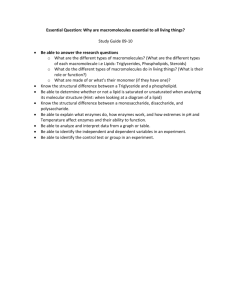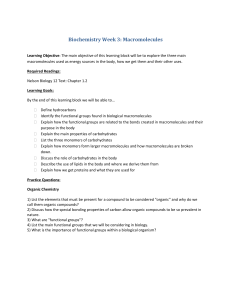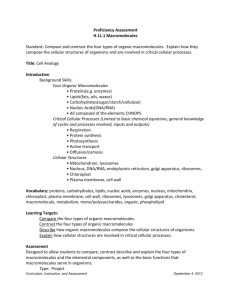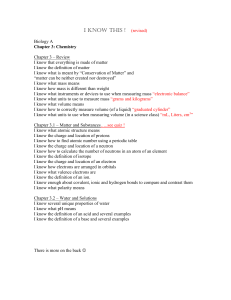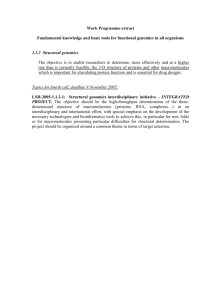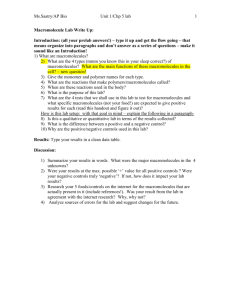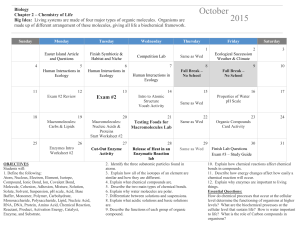H.1L.1 Macromolecules Assessment 1
advertisement
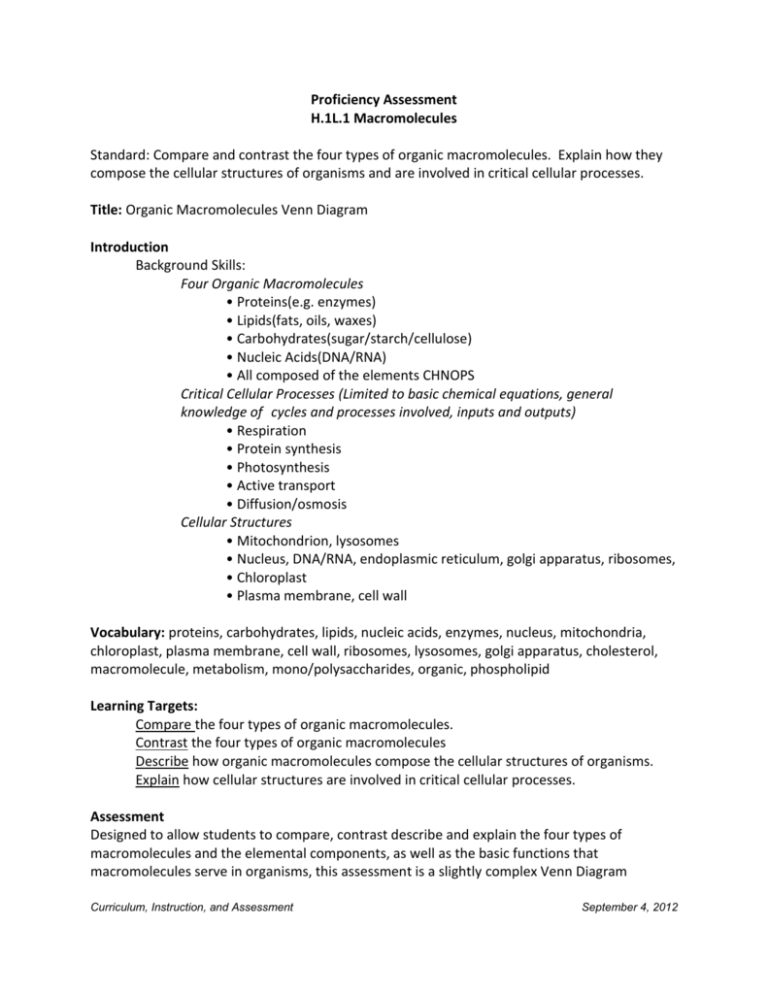
Proficiency Assessment H.1L.1 Macromolecules Standard: Compare and contrast the four types of organic macromolecules. Explain how they compose the cellular structures of organisms and are involved in critical cellular processes. Title: Organic Macromolecules Venn Diagram Introduction Background Skills: Four Organic Macromolecules • Proteins(e.g. enzymes) • Lipids(fats, oils, waxes) • Carbohydrates(sugar/starch/cellulose) • Nucleic Acids(DNA/RNA) • All composed of the elements CHNOPS Critical Cellular Processes (Limited to basic chemical equations, general knowledge of cycles and processes involved, inputs and outputs) • Respiration • Protein synthesis • Photosynthesis • Active transport • Diffusion/osmosis Cellular Structures • Mitochondrion, lysosomes • Nucleus, DNA/RNA, endoplasmic reticulum, golgi apparatus, ribosomes, • Chloroplast • Plasma membrane, cell wall Vocabulary: proteins, carbohydrates, lipids, nucleic acids, enzymes, nucleus, mitochondria, chloroplast, plasma membrane, cell wall, ribosomes, lysosomes, golgi apparatus, cholesterol, macromolecule, metabolism, mono/polysaccharides, organic, phospholipid Learning Targets: Compare the four types of organic macromolecules. Contrast the four types of organic macromolecules Describe how organic macromolecules compose the cellular structures of organisms. Explain how cellular structures are involved in critical cellular processes. Assessment Designed to allow students to compare, contrast describe and explain the four types of macromolecules and the elemental components, as well as the basic functions that macromolecules serve in organisms, this assessment is a slightly complex Venn Diagram Curriculum, Instruction, and Assessment September 4, 2012 students will fill in. Students should have exposure to Venn Diagram formats prior to attempting this assessment. Type: Diagram Time needed: Less than 1 class period Materials: Paper and pencil Directions: Deliver student task description and scoring guide to students. Give them time to draw and write. Curriculum, Instruction, and Assessment September 4, 2012 Organic Macromolecules Venn Diagram Fill in the Venn diagram with the organic macromolecules and their characteristics and properties. Include elements commonly found in each, uses for each in livings, examples of each, what cell parts are made of each, what cell parts use each, and what processes involve each. On a separate piece of notebook paper, explain the placements in your Venn diagram. Explain the effects of an increase or decrease in one or more organic macromolecules on a cell and its processes. Curriculum, Instruction, and Assessment September 4, 2012 Check list H.1L.1 Organic Macromolecules Include the Following Heading Title Name (First and Last) Date Class Elements Spelling Conventions (capitalization, punctuation, paragraphs) Use vocabulary from state standard: proteins, carbohydrates, lipids, nucleic acids, enzymes, nucleus, mitochondria, chloroplast, plasma membrane, cell wall, ribosomes, lysosomes, golgi apparatus, cholesterol, macromolecule, metabolism, mono/polysaccharides, organic, phospholipid See Directions/procedures Scoring See rubric Format Labels Written explanation Curriculum, Instruction, and Assessment Evidence = X September 4, 2012 Scoring Guide H.1 L.1 Macromolecules Standard: Compare and contrast the four types of organic macromolecules. Explain how they compose the cellular structures of organisms and are involved in critical cellular processes. Score Description: 4.0 Exceeds Explain how changes in the four organic macromolecules would affect cell composition and cell processes. 3.5 Can complete level 3.0 and can partially complete level 4.0. 3.0 Meets Compare and contrast the four types of organic macromolecules (proteins, carbohydrates, lipids and nucleic acids) and explain how they are used in cell composition and processes. 2.5 Can complete level 2.0 and can partially complete level 3.0 or 4.0 2.0 Nearly meets List the four types of organic macromolecules and state where they can be found in the cell. 1.5 Can complete level 1.0 and can partially complete level 2.0, 3.0, or 4.0. 1.0 Beginning Recognize that there are different types of organic macromolecules and that they are used in cells in different ways, with help 0.5 Can produce some evidence of basic knowledge, with help. 0.0 Has no understanding Cannot provide any evidence of knowledge or understanding, even with help. Curriculum, Instruction, and Assessment September 4, 2012
